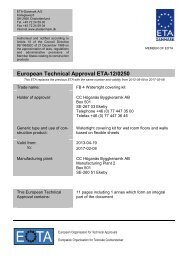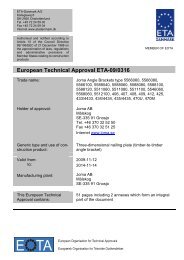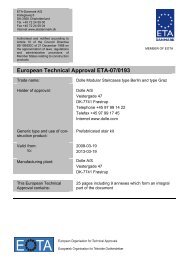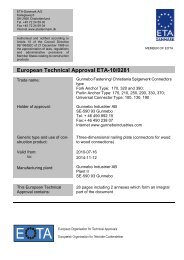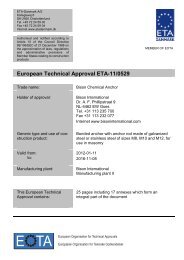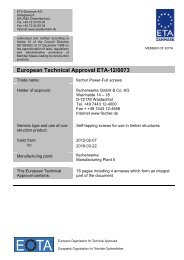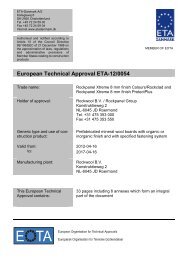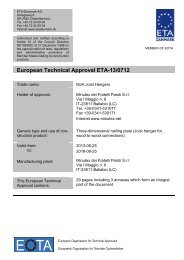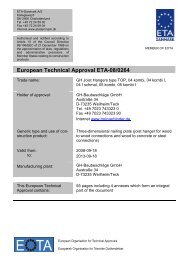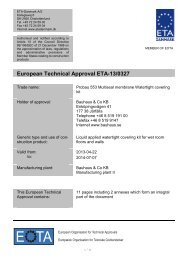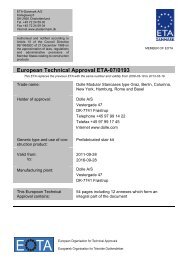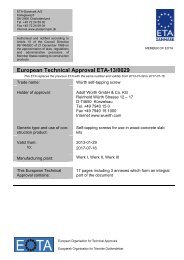European Technical Approval ETA-09/0364 - ETA-Danmark
European Technical Approval ETA-09/0364 - ETA-Danmark
European Technical Approval ETA-09/0364 - ETA-Danmark
You also want an ePaper? Increase the reach of your titles
YUMPU automatically turns print PDFs into web optimized ePapers that Google loves.
Safety principles and partial factors<br />
Page 5 of 18 of <strong>European</strong> <strong>Technical</strong> <strong>Approval</strong> no. <strong>ETA</strong>-<strong>09</strong>/<strong>0364</strong><br />
The characteristic load-carrying capacities are based on the<br />
characteristic values of the nail connections and the steel<br />
plates. To obtain design values the capacities have to be<br />
multiplied with different partial factors for the material<br />
properties, in addition the nail connection with the<br />
coefficient kmod.<br />
According to EN 1990 (Eurocode – Basis of design)<br />
paragraph 6.3.5 the design value of load-carrying capacity<br />
can be determined by reducing the characteristic values of<br />
the load-carrying capacity with different partial factors.<br />
Thus, the characteristic values of the load–carrying<br />
capacity are determined also for timber failure FRk,H<br />
(obtaining the embedment strength of nails subjected to<br />
shear or the withdrawal capacity of the most loaded nail,<br />
respectively) as well as for steel plate failure FRk,S. The<br />
design value of the load–carrying capacity is the smaller<br />
value of both load–carrying capacities.<br />
⎧⎪ kmod ⋅FRk,H<br />
FRk,S<br />
⎫⎪<br />
FRd = min ⎨ ; ⎬<br />
⎪⎩ γM,H γM,S<br />
⎪⎭<br />
Therefore, for timber failure the load duration class and the<br />
service class are included. The different partial factors γM<br />
for steel or timber, respectively, are also correctly taken<br />
into account.<br />
2.1 Mechanical resistance and stability<br />
See annex B for the characteristic load-carrying capacity in<br />
the different directions F1 to F7.<br />
The characteristic capacities of the angle brackets are<br />
determined by calculation assisted by testing as described<br />
in the EOTA Guideline 015 clause 5.1.2. They should be<br />
used for designs in accordance with Eurocode 5 or a similar<br />
national Timber Code.<br />
Threaded nails (ringed shank nails) in accordance to<br />
prEN 14592<br />
In the formulas in Annex B the capacities for threaded<br />
nails calculated from the formulas of Eurocode 5 are<br />
used assuming a thick steel plate when calculating the<br />
lateral nail load-carrying-capacity.<br />
The load bearing capacities of the brackets has been<br />
determined based on the use of connector nails 4,0 x 40<br />
mm in accordance with the German national approval for<br />
the nails.<br />
The characteristic withdrawal capacity of the nails has to be<br />
determined by calculation in accordance with EN 1995-1-<br />
1: 2004, paragraph 8.3.2 (head pull-through is not<br />
relevant):<br />
Fax,Rk = fax,k × d × tpen<br />
Where:<br />
fax,k<br />
Characteristic value of the withdrawal parameter in<br />
N/mm 2<br />
d Nail diameter in mm<br />
tpen<br />
Penetration depth of the profiles shank in mm tpen ≥<br />
30 mm<br />
Based on tests by Versuchsanstalt für Stahl, Holz und<br />
Steine, University of Kalrsruhe, the characteristic value of<br />
the withdrawal resistance for the threaded nails used can be<br />
calculated as:<br />
fax,k = 50 × 10 -6 × σk 2<br />
Where:<br />
σk<br />
Characteristic density of the timber in kg/m 3<br />
The shape of the nail directly under the head shall be in the<br />
form of a truncated cone with a diameter under the nail<br />
head which exceeds the hole diameter.<br />
No performance has been determined in relation to ductility<br />
of a joint under cyclic testing. The contribution to the<br />
performance of structures in seismic zones, therefore, has<br />
not been assessed.<br />
No performance has been determined in relation to the<br />
joint’s stiffness properties - to be used for the analysis of<br />
the serviceability limit state.<br />
2.7 Related aspects of serviceability<br />
2.7.1 Corrosion protection in service class 1 and 2.<br />
In accordance with <strong>ETA</strong>G 015 the angle brackets are made<br />
from steel DD 11 according to EN 10111:1998 + Z 275<br />
according to EN 10327:2004



